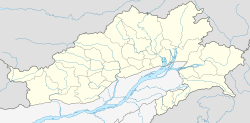Asaphila
Asaphila | |
|---|---|
Forest | |
| Coordinates: 28°26′N 93°10′E / 28.43°N 93.17°E / 28.43; 93.17 | |
| Country | India, Tibet region of China |
| State/Prefecture | Arunachal Pradesh, Shannan Prefecture |
| Subdivision | Upper Subansiri, Lhünzê County |
Asaphila or Asafila[a] is a mountainous forest area near the China–India border along the Subansiri River valley.[5] It is at the southwestern corner of the Tsari region, straddling Lhünzê County in the Shannan Prefecture of Tibet, and the Taksing Circle in the Upper Subansiri district of Arunachal Pradesh, India. Occasional border disputes between the two countries in the region are reported.[6]
Description
According to former Indian Army chief V. P. Malik, Asaphila is a 100 km2 of densely forested mountainous area to the west of the town of Taksing in Arunachal Pradesh. It spans both sides of the Line of Actual Control in Tibet and India, including the valleys of Subansiri River (called Chayul Chu in Tibet) and Yume Chu. It is sparsely populated. Only foot tracks are available for movement in the area.[5]
The nearest road link on the Indian side is at Taksing, for which the Indian Border Roads Organisation laid a road by 2018.[7]
China has built a trunk road[b] which circles around the Tsari region, passing by the village of Lung in the Subansiri valley, and through Charme, Chösam and Migyitun. Link roads to Lung and Yume also exist, but they have not yet been extended up to the border with India.[8]
History
Sino-Indian War
During the 1962 Sino-Indian War, the Chinese attacked the Indian border posts in the area with a battalion of troops. A post in Asaphila, and others at Shagam La, Tama La and Potrang came under attack on 23 October 1962. The 2nd battalion of Jammu and Kashmir Rifles, which was deployed in the area, suffered 18 casualties included a JCO. As a result, on 26 October, the Indian headquarters ordered all the border posts from the Subansiri valley as well as the Tsari Chu valley to withdraw to Taliha.[9]
After the war, the Chinese withdrew to their previous positions, except that they retained possession of the Longju area in the Tsari Chu valley.
Border incidents
Reports of PLA intrusions in the Asaphila area have been reported in 2003 and 2005.[10] In 2003, a Chinese patrol disarmed an Indian non-military patrol in the area.[5] In May 2012 thirty soldiers of the People's Liberation Army entered Asaphila and destroyed an Indian patrol hut.[11] In 2014, Indian soldiers blocked Chinese road construction in the area.[12] In 2018 China accused India of large scale transgressions into Asaphila.[13][14]
Notes
- ^ Variations on the spelling include Ashafila,[1] Asaphi La,[2] Asa-Pila-Maya[3] and Asapila.[4]
- ^ The trunk road is labelled as "G219" on OpenStreetMap. Evidently, it is separate from the China National Highway 219 in western Tibet.
References
- ^ How much land did Arunachal Pradesh lose to China after 1962 war?, EastMojo, 24 June 2020.
- ^ Bajwa, Lt Gen JS (2017), CHINA: Threat or Challenge?, Lancer Publishers LLC, ISBN 978-1-940988-29-0
- ^ Chinese PLA now targets Taksing zone in Arunachal Pradesh, Deccan Chronicle, 27 October 2014.
- ^ Kalita, Prabin (19 September 2020). "Defence forces on toes in six areas along LAC in Arunachal Pradesh". The Times of India. Archived from the original on 2020-09-19. Retrieved 2021-07-09.
- ^ a b c Malik, General (Retd) V. P. (12 August 2003). "Sino-Indian Asaphila Patrolling Face-off". Observer Research Foundation. Retrieved 2021-02-10.
- ^ Travis Wheeler, Clarify and Respect the Line of Actual Control, Stimson Center, 10 May 2019. Note 56.
- ^ "BRO extends road connectivity upto Taksing in China border". The Economic Times. PTI. 17 May 2018.
- ^ Chinese Trunk Road (G219) in the vicinity of Asaphila, OpenStreetMap, retrieved 11 February 2021.
- ^ Sandhu, P. J. S.; Shankar, Vinay; Dwivedi, G. G. (2015-08-06). 1962: A View from the Other Side of the Hill. Vij Books India Pvt Ltd. p. 110. ISBN 978-93-84464-37-0.
- ^ Rajan, D.S. (March 2015). "Will Chinese Intrusions into India's Borders Ever End?". Chennai Centre for China Studies.
- ^ Shukla, Saurabh (17 October 2012). "Growing intrusion by the Chinese army on the LAC has set the alarm bells ringing in South Block. Can the Indian Army maintain restrain?". India Today.
- ^ Kumar, Satish (2016-10-04). "2 (ii)". India's National Security: Annual Review 2015–16. Taylor & Francis. p. 77. ISBN 978-1-315-39011-6.
- ^ "Indian Army rejects China's accusations of 'transgression' in Arunachal, says it would continue patrols up to LAC". The Indian Express. 2018-04-08. Retrieved 2021-02-10.
- ^ "China Objects to 'Transgression' in Arunachal's Asaphila; That's Our Area, Says India". News18. PTI. 2018-04-08.
External links
- Bhattacharya, Rajeev (8 December 2015). "The Border Villages of Arunachal Pradesh: A Story of Neglect". The Caravan.
- Soldiers patrol in Asaphila area. China Military Online.


